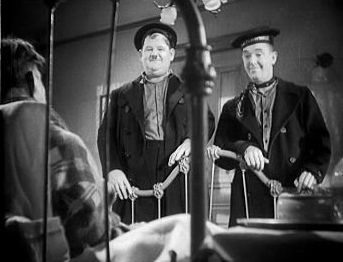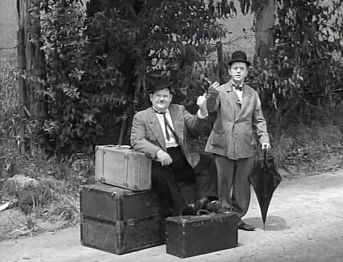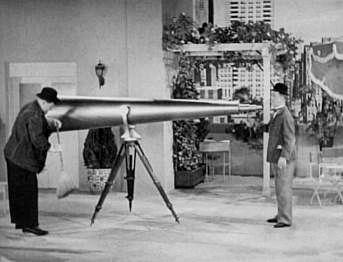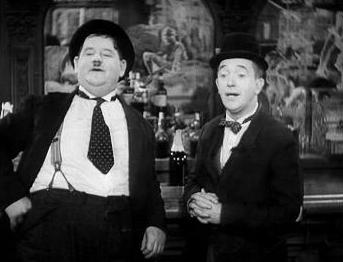(February-May 1936, 73m) Director: Harry Lachman Released: MGM, October 30, 1936  While Laurel and Hardy were fine comedians, their films never aspired to overt artistic statement and there is a 'job lot' feel to the making of many of them. While love and care has clearly gone into producing the pictures, poor editing and continuity are frequent throughout their body of work. Often this can be attributed to production time and costs, but while fondly-remembered mainstream comedians, Laurel and Hardy never were - nor ever claimed to be - Chaplin, Lloyd or Keaton. With this in mind then Our Relations is a film shot with a cinematic vision in mind, photography by Rudolph Mat� perfectly complimenting the thoughtful direction by Harry Lachman. On a purely technical level it's arguably the best thing they ever did. However, the question the audience has to ask is: is Arthur Housman funnier when he's shot through an aquarium, and is a cake being placed on top of Ollie's head funnier when it's introduced with an aerial shot? Laurel and Hardy is all about spontaneity, or the illusion of spontaneity, so this precision-executed feature with an intricate 'twin brothers' plot may lack the usual chemistry for some, however admirable it looks onscreen. With Our Relations and the following feature, Way Out West, Stan was temporarily appeased by having his name as producer on the credits. The central plotline was based on W.W. Jacobs's 1903 short story 'The Money Box', and features all the storyline with two sailors lending their money to an older sailor, pawning his clothes and being told their money is sewn up in the lining and so on. It even features, ironically, the phrase 'you've made a nice mess of it'. However, none of the elements of gangsters or identical doubles are part of this basic framework, a Shakespearean coincidence that gets alluded to in the screenplay. Overall this stands alongside the likes of Fra Diavolo, after a fashion, of being one of their most sophisticated pieces, and certainly the decision to release a colorized version is at odds with the superb lighting. However, it's also pure Stan and Ollie, and possibly their most violent film, too - Stan (accidentally) head butts a man in the face while they force James Finlayson to swallow a broken light bulb. It's everything you'd expect from a Laurel and Hardy film, only with the plot a little more complex and the production a little more polished.     (April 1936, 18m) Director: Charles Parrott and Harold Law Released: MGM, April 18, 1936  Co-directed by Charlie Chase under his real name of Charles Parrott, On The Wrong Trek is an effortlessly charming comedy of errors cum road movie. When Chase (a world away from his obnoxious Sons of the Desert persona), tries to take a vacation, everything that can go wrong, does go wrong. Chase's considerable personal charisma and rapport with his co-stars adds to a highly likeable and amusing short that includes a brief silent cameo from Laurel and Hardy as they attempt to hitch-hike at a roadside. Sadly, this was the final short that Chase made for Hal Roach. With Roach eager to move onto features with all of his acts, he made a feature with Chase titled Neighborhood House, but after previews it was edited down to a two-reeler. A supporting role in the Patsy Kelly feature Kelly The Second followed, after which Chase was released from the Roach studios and began working for Columbia. During this period Chase's alcoholism was getting worse and effecting his health... it's somewhat of a tragic realisation that just over four years after making On The Wrong Trek the star died of a heart attack aged just forty-six.     c. 1936  Sometime around this point Stan, Ollie and James Finlayson took part in a trailer for MGM movies aimed at the European and African markets. With its existence long forgotten, the footage was only recently found and exists only in a dubbed French version (Though Ollie's yells and Finlayson's 'd'oh!' are their own). The sequence lasts just over three minutes and features Stan and Ollie trying to look through a telescope at MGM's stars, only to be warned off by Finlayson. Eventually they accidentally break the telescope and Ollie falls down a lift shaft. Dating and details of the trailer still remain sketchy, though discussion of a 1936 musical comedy would appear to place it within this time frame.    (May-November 1936, 65m) Director: James W. Horne Released: MGM, April 16, 1937  Laurel and Hardy's most perfect feature film, and their most iconographic this side of a piano up a flight of stairs. Oscar-nominated for its score, what really aids Way Out West is that the songs, unlike many of the other musicals, are part of its narrative. Although some of the routines - Stan with an alternating deep/female voice for one - were done before in The Bohemian Girl, here they're made standouts in a film which acts more as a star vehicle for the two leads. Their rendition of 'The Trail of the Lonesome Pine' was so popular that it was a top three hit in the UK singles chart nearly forty years after the film was released. Although not their funniest film in a purely visceral sense, Way Out West is arguably their best structured, and is far more than the sum of its parts. With a subplot involving 'red Indians' jettisoned, it's a streamlined hour with the boys where everything falls perfectly into place. There's the occasional reuse of old gags (not just in the way the 'falling down a previously unseen mudhole' gets a seven-year resurrection not once, but twice, but in the way Stan riffs on Chaplin's shoe eating routine from City Lights) but its always in the sense of two craftsmen revisiting previous joys and honing them, making them even better. The age of the Fox movie, where old routines would be recreated with no logical reason, is still in the future: this is Stan and Ollie still in their primes producing arguably their greatest film of all. In 1959 Stan wrote to a fan about Way Out West remarking that it was 'one of my favorites, had a lot of fun making that one. It had great appeal to big audiences - lots of laughs.' He also went on to describe the trick behind the thumb lighting routine, explaining that 'I wore a false thumb with cotton with lighter fluid in the end. I would make the motion of flicking the lighter then the camera stopped & the false thumb was put on & lit with a match, the camera started again, so it looked like it actually happened.' In real life then Hardy's long-disintegrating marriage to Myrtle had finally ended in divorce on May 18th and Stan had separated from his second wife Ruth. That such a perfect film can come out of such troubled times is nothing short of remarkable.      (November 1936-January 1937, 69m) Director: Edward Sedgwick Released: MGM, May 21, 1937 A cameo role in a feature here, a fresh review on this one is pending...   
|
||||||||||||||||||||||||||||||||||||||||||||||||||||||||||||||||||||||||